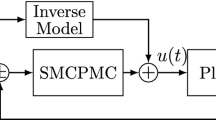Abstract
Pneumatic systems are a simple and readily available technology that presents high force to volume ratios. Their use is nevertheless restricted to simple motion tasks, given the complexity in its modelling and control. One of the main aspects contributing to this panorama is the difficulty in accurately predicting friction forces. In fact, although it is possible to find in literature complex friction models that suit well a particular experimental set-up, its practical use becomes hindered given the diversity of pneumatic actuated systems found in industry. This paper presents a new controller that achieves very good results even without a friction model. The controller architecture includes a robust motion control loop and a non-linear state feedback pneumatic force loop. The motion controller law is based on integral sliding control and takes into account the pneumatic dynamics, using it as a natural filter of the discontinuous part of the control law. Experimental results show that the proposed approach leads to low tracking and positioning errors. These results are obtained without including a friction model and even in the presence of parameter disturbances caused by a fivefold payload change, without any controller retuning or excessive control action activity.
Similar content being viewed by others
References
Kim C, Chung J, Hong D (2008) Coordination control of an active pneumatic deburring tool. Robot Comput Integr Manuf 24:426–471
Li H, Kawashima K, Tadano K, Ganguly S, Nakano S (2013) Achieving haptic perception in forceps’ manipulator using pneumatic artificial muscle. IEEE/ASME Trans Mechatron 18:74–85
Le MQ, Pham MT, Tvakoli M, Moreau R (2011) Sliding mode control of a pneumatic haptic teleoperation system with on/off valves, IEEE Int. Conf. on Robot. and Autom. Shangai, China, pp 874–879
Shen X, Goldfarb M (2006) On the enhanced passivity of pneumatically actuated impedance-type haptic interfaces. IEEE Trans Robot 22:470–480
Senkal D, Gurocak H (2011) Haptic joystick with hybrid actuator using air muscles and spherical MR-brake. Mechatronics 21:951–960
Noritsugu T, Tanaka T (1997) Application of rubber artificial muscle manipulator as a rehabilitation robot. IEEE/ASME Trans Mechatron 2:259–267
Zhang J-F, Yanga C-J, Chena Y, Zhanga Y, Donga Y-M (2008) Modeling and control of a curved pneumatic muscle actuator for wearable elbow exoskeleton. Mechatronics 18:448–457
Chen Y, Zhang JF, Yang CJ, Niu B (2007) Design and hybrid control of the pneumatic force-feedback systems for arm-exoskeleton by using on/off valve. Mechatronics 17:325–335
Ferris D, Gordon K, Sawicki G, Peethambaran A (2006) An improved powered ankle–foot orthosis using proportional myoelectric control. Gait Posture 23:425–428
Wait K, Goldfarb M (2014) A pneumatically actuated quadrupedal walking robot. IEEE/ASME Transac Mech 19:339–347
Rosendo A, Nakatsu S, Narioka K, Hosod K (2013) Pneupard: a biomimetic musculoskeletal approach for a feline-inspired quadruped robot. 2013 IEEE/RSJ International Conference on Intelligent Robots and Systems (IROS). Tokyo, Japan, pp 1452–1457
Meng D, Tao G, Zhu X (2013) Integrated direct/indirect adaptive robust motion trajectory tracking control of pneumatic cylinders. Int J Control 86:1620–1633
Kokotovic PV (1992) The joy of feedback: nonlinear and adaptive. IEEE Control Syst Mag 12:7–17
Plestan F, Shtessel Y, Brégeault V, Poznyak A (2013) Sliding mode control with gain adaptation - application to an electropneumatic actuator. Control Eng Pract 21:679–688
Weist J, Arteaga M, de la Cruz L, Hebisch H (2011) Model free control for differential pneumatic pistons: experimental comparison. Int J Control 84:138–164
Ning S, Bone G (2005) Experimental comparison of two pneumatic servo position control algorithms, Proc. of the IEEE International Conference on Mechatronics & Automation. Niagara Falls, Canada, pp 37–42
Arteaga-Pérez M, Castillo-Sánchez AM, Parra-Vega V (2006) Cartesian control of robots without dynamic model and observer design. Automatica 42:473–480
Carneiro JF, Almeida FG (2012) A high-accuracy trajectory following controller for pneumatic devices. Int J Adv Manuf Technol 61:253–267
Carneiro JF, Almeida FG (2013) Micro tracking and positioning using off-the-shelf servopneumatics. Robot Comput Integr Manuf 30:244–255
Ozguner U, Utkin VI, Young KD (1999) A control engineer’s guide to sliding mode control. IEEE Trans Control Syst Technol 7:328–342
Slotine JJ, Sastry SS (1984) Sliding controller design for non-linear systems. Int J Control 40:421–434
Slotine JJ, Sastry SS (1983) Tracking control of nonlinear systems using sliding surfaces with application to robot manipulator. Int J Control 38:465–492
Carneiro JF, Almeida FG (2011) VSC approach angle based boundary layer thickness: a new variation law and its stability proof. Proc. of the 2011 Bath Symp. on Fluid Power and Motion Control/ ASME 2011 Dyn. Syst. and Control Conf. Arlington, VA, USA, pp. paper DSCC2011–5948
Zinober AS, EI-Ghezawi OME, Billings SA (1982) Multivariable variable structure adaptive model-following control systems. Proc Inst Elect Eng 129:6–12
Levant A (1993) Sliding order and sliding accuracy in sliding mode control. Int J Control 58:1247–1263
Utkin V, Shi J (1996) Integral sliding mode in systems operating under uncertainty conditions, Decision and Control, 1996. Proceedings of the 35th IEEE Conference on 1996, pp 4591–4596
Komsta J, Oijen N, Antoszkiewicz P (2013) Integral sliding mode compensator for load pressure control of die-cushion cylinder drive. Control Eng Pract 21:708–718
Carneiro JF, Almeida FG (2012) A macro–micro motion servopneumatic device. Proc Inst Mech Eng I J Syst Control Eng 226:775–786
Carneiro JF, Almeida FG (2012) A neural network based nonlinear model of a servopneumatic system. ASME J Dyn Syst Meas Control 134:024502 (8 pages)
Carneiro JF, Almeida FG (2006) Reduced order thermodynamic models for servopneumatic actuator chambers. Proc Inst Mech Eng I J Syst Control Eng 220:301–314
Carneiro JF, Almeida FG (2007) Heat transfer evaluation on industrial pneumatic cylinders. Proc Inst Mech Eng I J Syst Control Eng 221:119–128
Carneiro JF, Almeida FG (2013) Using two servovalves to improve pneumatic force control in industrial cylinders. Int J Adv Manuf Technol 66:283–301
Author information
Authors and Affiliations
Corresponding author
Rights and permissions
About this article
Cite this article
Carneiro, J.F., de Almeida, F.G. Accurate motion control of a servopneumatic system using integral sliding mode control. Int J Adv Manuf Technol 77, 1533–1548 (2015). https://doi.org/10.1007/s00170-014-6518-8
Received:
Accepted:
Published:
Issue Date:
DOI: https://doi.org/10.1007/s00170-014-6518-8




